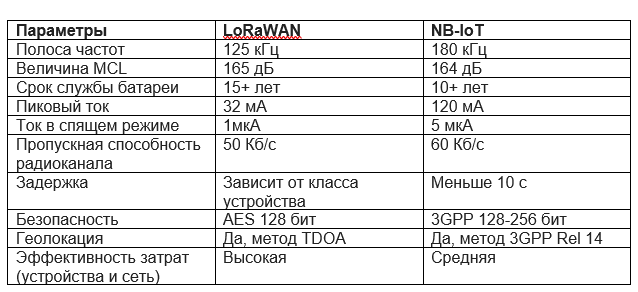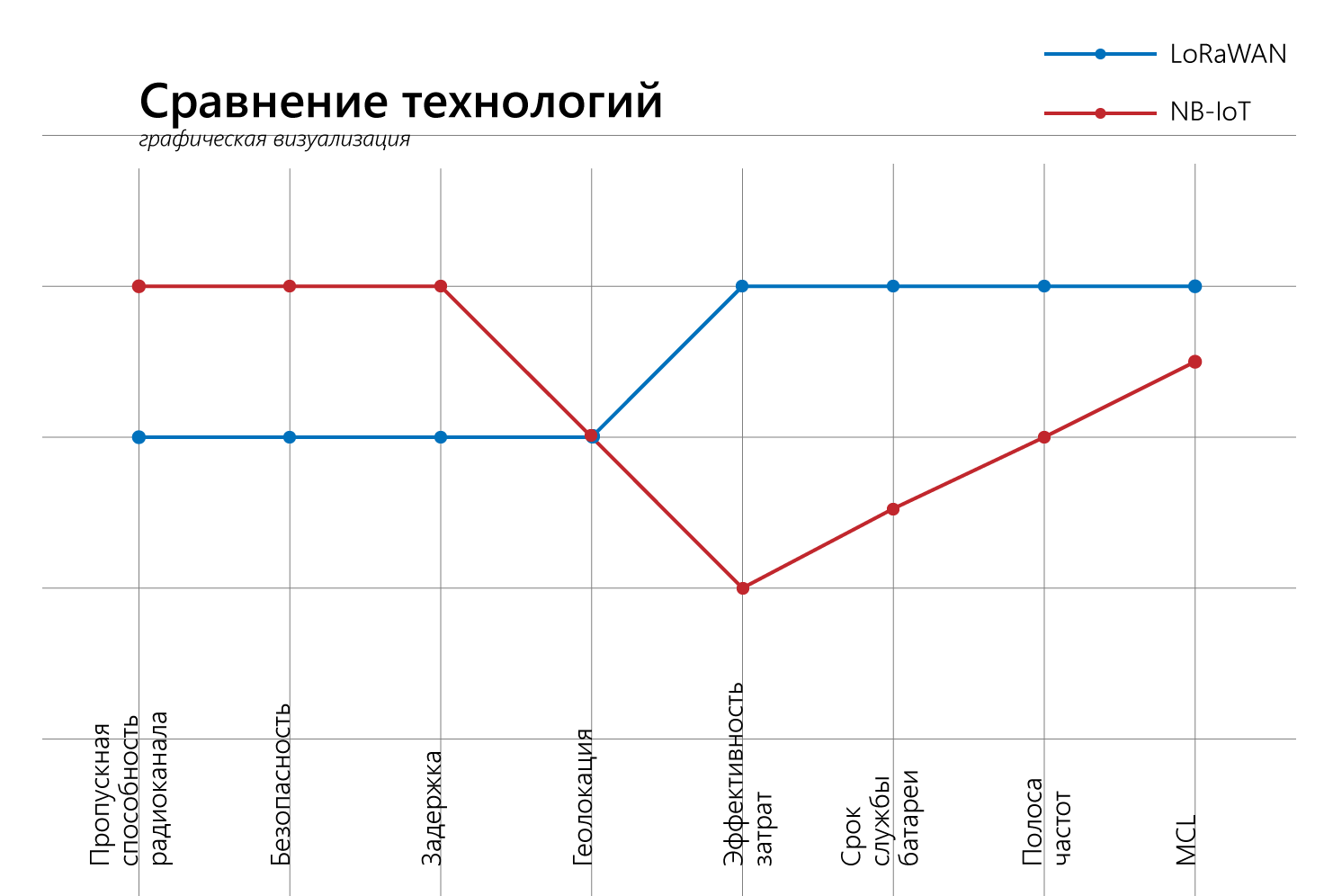Introduction
LPWA (Low-Power Wide-Area) technologies serve the needs of the Internet of Things (IoT) market with cheap devices that hold the battery for a long time and cheap long-distance networks while maintaining a huge number of connections. There are several options for building LPWA networks, but LoRaWAN and NB-IoT technologies have shown the greatest dynamics and will receive the largest LPWA market share in the coming years. In this text, these technologies will be considered in terms of common features and differences. We then move on to examples of using LoRaWAN in vertical markets, highlighting the unique benefits of LoRaWAN. Possible options will also be considered when LoRaWAN and NB-IoT will work together to achieve the greatest benefits.
Comparison of LoRaWAN and NB-IoT in technical terms
LoRaWAN is an open architecture LPWAN system developed and standardized by the nonprofit association of companies LoRa Alliance, which has more than 500 members. LoRa is a modulation technology used at the physical level, which allows long-range energy-efficient data transmission using CSS (Chirp Spread Spectrum) modulation, which distributes narrow-band signals over an extended channel, which ensures high noise immunity and low signal to noise ratio. NB-IoT, for its part, operates in the licensed range and, like LTE, uses uplink frequency division multiple access (FDMA), downlink orthogonal FDMA (OFDMA) and QPSK (Quadrature Phase Shift Keying) modulation. Although both technologies can compete in quality of service (QoS), IoT applications requiring frequent communication will feel better with NB-IoT, which has no restrictions on the work cycle in the licensed range, but at the full cost of providing a system is more expensive than LoRaWAN.


Both LoRaWAN and NB-IoT devices consume less power when they enter sleep mode. But while operating as a synchronous protocol, NB-IoT consumes significantly more power than LoRaWAN, which is an asynchronous protocol, and when measuring with the same throughput, NB-IoT consumes a higher peak current required for OFDM / FDMA modulation. Despite this, the characteristics of both technologies are important in the implementation of many practical solutions that require high penetration indoors and years of battery life.
For corporate customers who want to deploy a hybrid network using both private and public network infrastructure, it is best to use LoRaWAN for several reasons. With private LoRaWAN networks, enterprises are not limited by business and financial reasons for data transfer. Where possible, access to the corporate network can be supplemented by the public LoRaWAN network. NB-IoT connectivity is currently offered in areas where there is already cellular coverage, but deployment costs are higher compared to LoRaWAN, since deploying a private network will require the purchase or rental of RF spectrum from network operators. Another factor affecting the relative cost and performance of LoRaWAN and NB-IoT is LoRaWAN's best penetration performance in rooms. The maximum communication loss (MCL) for the LoRaWAN uplink and downlink is 165 dB; the MCL for NB-IoT can range from 145 dB to 169 dB for the uplink and 151 dB for the downlink, depending on the device class. In addition, the lower energy potential of the NB-IoT communication link leads to a decrease in battery life.
More LoRa devices than NB-IoT
According to the LoRa Alliance, as of April 2019, there are more than 113 LoRaWAN networks in 55 countries worldwide at various stages of commercial deployment compared to 90 NB-IoT networks. According to the LoRa Alliance, there are 118 LoRaWAN devices that are certified by the LoRa Alliance. At the same time, according to the Global Association of Mobile Suppliers, NB-IoT and CAT-M commercial devices in total 43. According to Semtech Corporation, as of April 2019, the total number of LoRa end devices reached 97 million. The growth of LoRaWAN solutions is accelerating because the ecosystem of devices is expanding rapidly to cover a wider range of vertical markets.
Utility services
LoRaWAN has gained popularity thanks to utilities that connect smart meters for gas and water. China was one of the first to introduce LoRa technology for smart metering projects, accounting for about 65% of the chips shipped in 2018. Birdz, a subsidiary of Novo Veolia and Veolia Water, announced on December 19, 2018 that it chose Orange Business Services (OBS) to connect 3 million LoRaWAN smart water meters. The Veolia contract is the largest implementation of smart water meters using the LPWA public network. Energy companies, which are at more advanced stages of implementing smart meters, are now starting to modernize their medium-voltage (MV) and high-voltage (HV) electrical infrastructures. ABB, a leader in electrification solutions, has announced LoRaWAN's voltage limiters that measure discharge current and leakage current. The LoRa Alliance and DLMS jointly announced in April 2019 their collaboration to provide a new DLMS profile adapted for LoRaWAN networks, allowing utilities to use many IoT applications and allowing the use of DLMS / COSEM protocol to connect smart electricity meters with LoRaWAN.
Smart buildings
IoT solutions that use sensors to monitor various environmental conditions, such as temperature, humidity, and light, as well as to detect movement, shock, and water leaks, are increasingly being used in commercial buildings.
Smart buildings also include space management solutions that use room sensors to provide real-time information on space utilization for access to the workplace and conference rooms, as well as the optimal use of HVAC systems (heating / ventilation / air conditioning). Knowing fullness can also help building managers more efficiently manage software services such as cleaning, waste management, and security. LoRaWAN technology has achieved the greatest success in implementing these solutions and has advantages due to the availability of devices and the simplicity of creating networks with high penetrating power indoors. Intelligent base station vendors such as Cisco, MultiTech, Kerlink, TEKTELIC, and Laird provide micro and femto base stations that support between 3,000 and 7,000 connected terminals, respectively.
Logistics / Tracking assets (goods, resources, values)
Wireless enterprise asset tracking is one of the biggest opportunities on the IoT market, and LPWA network technologies will play an important role, collectively tracking over 9,500 million assets worldwide over the next 5 years. The biggest problem that LoRaWAN can solve is the visual presentation and tracking of goods in the supply chain, from the internal environment of the enterprise to megacities and regions using a single technology. Currently, product tracking is only available within buildings using short-range wireless technologies such as RFID, Bluetooth, UWB or Wi-Fi, or outdoors using cellular or satellite technology. On February 19, 2019, the aircraft manufacturer selected Objenious (a French Internet IoT company ) for its hybrid LoRaWAN infrastructure, which enabled it to track its products not only in factories, but also between factories using the public LoRaWAN network provided by Objenious. Another example is asset tracking systems that track vehicles carrying valuable goods. In Brazil, Maxtrack chose LoRaWAN and by the end of 2018 had placed more than 400,000 trackers to track vehicles and cargo.
Industry and smart manufacturing
One of the key factors of digital transformation in production is the industrial Internet of things. LoRa Alliance certified sensors allow you to use IoT applications in production to improve the visibility of the workflow, monitor equipment uptime to reduce downtime, view resource utilization, and examine overall performance. Industrial IoT applications capitalize on LoRaWAN’s low total cost of ownership and the flexibility to manage private networks to deploy wireless sensors to collect additional data points to provide new knowledge. Industrial solutions from Ineo-Sense and ADVEEZ testify to the introduction of IoT technologies in the automotive and aerospace industries.
Smart farming
According to the United Nations Food and Agriculture Organization (FAO), agriculture will have to increase productivity by 70% by 2050 to meet projected population growth.
IoT technologies will help make better use of resources to meet this projected demand for food. However, falling commodity prices made it difficult for a large block of producers, small and medium-sized farmers, to use various IoT technologies. LPWA network technologies allow you to implement flexible IoT solutions in two ways: firstly, the availability of low-cost devices for monitoring soil moisture or livestock conditions in order to increase yield or milk productivity; and, secondly, the creation of affordable networks for receiving information from sensors using LoRaWAN devices, instead of cellular networks that may not be available. As noted earlier, there are many suppliers of base stations for building private LoRaWAN networks.
Finally, in addition to LoRaWAN's already achieved success in enterprise solutions, ABI Research also anticipates a significant implementation of this technology for consumer solutions such as Smart Home. LoRaWAN supports connection both indoors and over long distances for devices located around the perimeter of an object. In addition, LoRaWAN battery performance is important for many battery-powered sensors used in solutions such as smoke detectors, water leak detection, smart locks, environmental monitoring, elderly care, and smart outdoor lighting. ABI Research also believes that B2B companies will also benefit from LoRaWAN smart home networks because expanding home network availability supports a wide range of use cases relevant for corporate clients, including cargo delivery verification, security and security monitoring.
Coexistence LoRaWAN and NB-IoT
As the IoT market continues to evolve, LoRaWAN and NB-IoT will coexist in the market, competing in some vertical markets and complementing each other in others, based on the requirements of specific IoT solutions for cost, coverage and bandwidth. Using the unlicensed spectrum, LoRaWAN will remain separate from other LPWA network technologies and will play a leading role in corporate private networks, where enterprises want full control over their infrastructure and devices. However, there are three situations where a need may arise for hybrid solutions using both LoRaWAN and NB-IoT.
The first situation is tracking mobile assets. As the footprints of LoRaWAN and NB-IoT continue to grow worldwide, the networks can also be complementary, providing the ubiquitous connectivity needed to track assets in multiple locations and regions.
The second situation is solutions for intelligent resource accounting and monitoring of energy systems. In Europe, the M-Bus protocol is mainly used for smart metering of gas and water, the ETSI ( European Telecommunications Standardization Institute) standard for smart metering. However, M-Bus was faced with shrinking the solution provider chain supporting this standard. This makes LoRaWAN a potential replacement for connecting WANs to smart, battery-powered meters. In addition, to implement resource accounting systems that use the architecture of base stations, as can be seen in the UK and Germany, LoRaWAN can connect meters and other terminal devices.
Finally, manufacturers of industrial equipment deploying remote monitoring solutions can greatly benefit from the LoRaWAN / NB-IoT combination wiring solution to increase both the functionality and flexibility for various industrial monitoring and control solutions. Optimized for long battery life, LoRaWAN technology can be used as the primary connectivity solution when sensors are needed to send monitoring data frequently. NB-IoT technology with its lower latency and guaranteed QoS, but higher cost, can be used less often for special remote control situations.
findings
LoRaWAN and NB-IoT networks have begun to deploy relatively recently, but they are already seeing rapid growth on a global scale. There will be a place for both LoRaWAN and NB-IoT among mass IoT applications based on the listed advantages: lower device costs, network infrastructure and network access; high penetration inside the building; and low power consumption. LoRaWAN, however, in the near future has a clear advantage over NB-IoT, with its developed supplier system, IoT-certified devices and integrated solutions that are already ready for implementation today.
Published June 10, 2019 by the analytical company ABI Research
Translated with permission from ABI Research